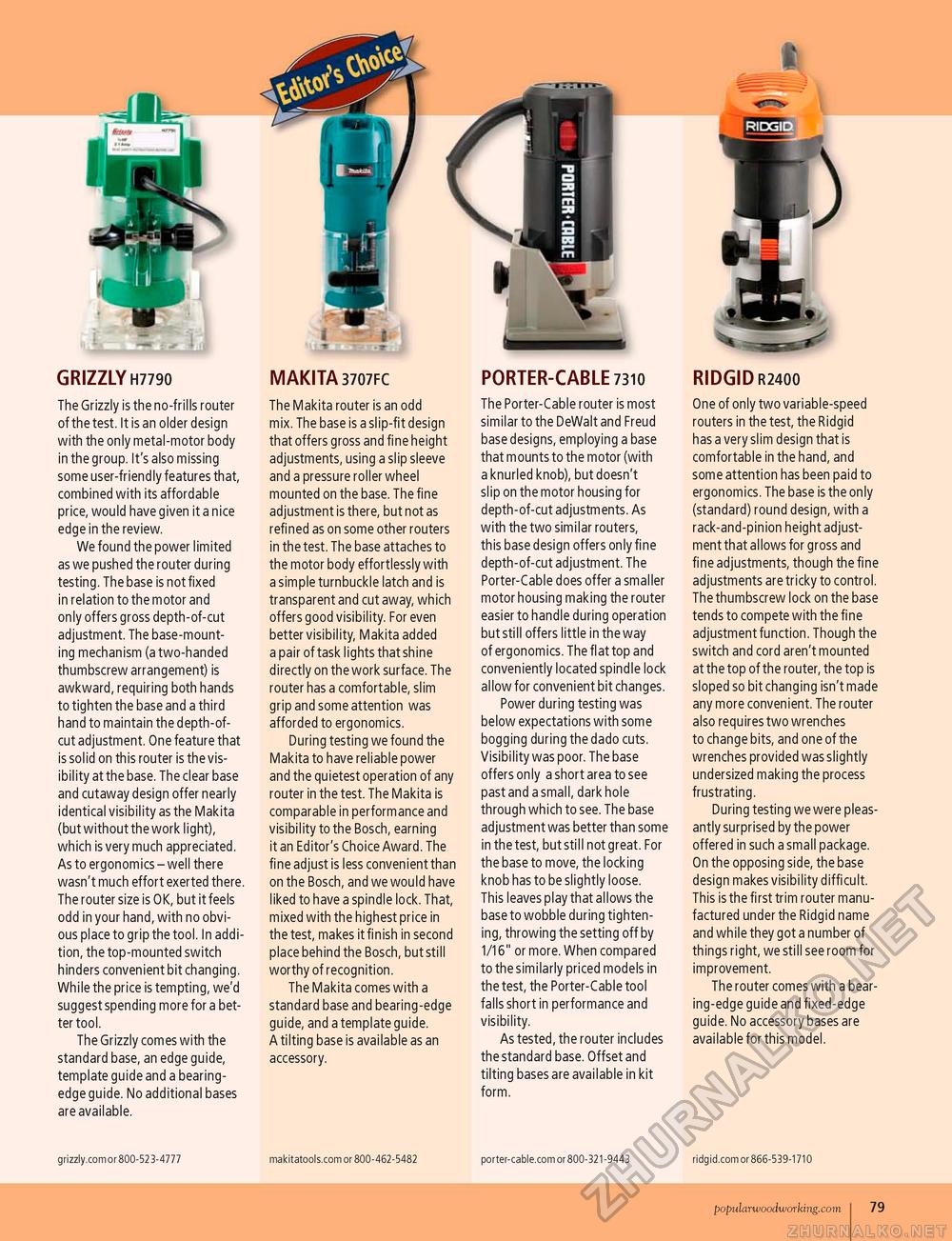Popular Woodworking 2006-06 № 155, страница 81
GRIZZLY H7790 The Grizzly is the no-frills router of the test. It is an older design with the only metal-motor body in the group. It's also missing some user-friendly features that, combined with its affordable price, would have given it a nice edge in the review. We found the power limited as we pushed the router during testing. The base is not fixed in relation to the motor and only offers gross depth-of-cut adjustment. The base-mounting mechanism (a two-handed thumbscrew arrangement) is awkward, requiring both hands to tighten the base and a third hand to maintain the depth-of-cut adjustment. One feature that is solid on this router is the visibility at the base. The clear base and cutaway design offer nearly identical visibility as the Makita (but without the work light), which is very much appreciated. As to ergonomics - well there wasn't much effort exerted there. The router size is OK, but it feels odd in your hand, with no obvious place to grip the tool. In addition, the top-mounted switch hinders convenient bit changing. While the price is tempting, we'd suggest spending more for a better tool. The Grizzly comes with the standard base, an edge guide, template guide and a bearing-edge guide. No additional bases are available. MAKITA 3707FC The Makita router is an odd mix. The base is a slip-fit design that offers gross and fine height adjustments, using a slip sleeve and a pressure roller wheel mounted on the base. The fine adjustment is there, but not as refined as on some other routers in the test. The base attaches to the motor body effortlessly with a simple turnbuckle latch and is transparent and cut away, which offers good visibility. For even better visibility, Makita added a pair of task lights that shine directly on the work surface. The router has a comfortable, slim grip and some attention was afforded to ergonomics. During testing we found the Makita to have reliable power and the quietest operation of any router in the test. The Makita is comparable in performance and visibility to the Bosch, earning it an Editor's Choice Award. The fine adjust is less convenient than on the Bosch, and we would have liked to have a spindle lock. That, mixed with the highest price in the test, makes it finish in second place behind the Bosch, but still worthy of recognition. The Makita comes with a standard base and bearing-edge guide, and a template guide. A tilting base is available as an accessory. PORTER-CABLE 7310 The Porter-Cable router is most similar to the DeWalt and Freud base designs, employing a base that mounts to the motor (with a knurled knob), but doesn't slip on the motor housing for depth-of-cut adjustments. As with the two similar routers, this base design offers only fine depth-of-cut adjustment. The Porter-Cable does offer a smaller motor housing making the router easier to handle during operation but still offers little in the way of ergonomics. The flat top and conveniently located spindle lock allow for convenient bit changes. Power during testing was below expectations with some bogging during the dado cuts. Visibility was poor. The base offers only a short area to see past and a small, dark hole through which to see. The base adjustment was better than some in the test, but still not great. For the base to move, the locking knob has to be slightly loose. This leaves play that allows the base to wobble during tightening, throwing the setting off by 1/16" or more. When compared to the similarly priced models in the test, the Porter-Cable tool falls short in performance and visibility. As tested, the router includes the standard base. Offset and tilting bases are available in kit form. RIDGID R2400 One of only two variable-speed routers in the test, the Ridgid has a very slim design that is comfortable in the hand, and some attention has been paid to ergonomics. The base is the only (standard) round design, with a rack-and-pinion height adjustment that allows for gross and fine adjustments, though the fine adjustments are tricky to control. The thumbscrew lock on the base tends to compete with the fine adjustment function. Though the switch and cord aren't mounted at the top of the router, the top is sloped so bit changing isn't made any more convenient. The router also requires two wrenches to change bits, and one of the wrenches provided was slightly undersized making the process frustrating. During testing we were pleasantly surprised by the power offered in such a small package. On the opposing side, the base design makes visibility difficult. This is the first trim router manufactured under the Ridgid name and while they got a number of things right, we still see room for improvement. The router comes with a bearing-edge guide and fixed-edge guide. No accessory bases are available for this model. grizzly.com or 800-523-4777 makitatools.com or 800-462-5482 porter-cable.com or 800-321-9443 ridgid.com or 866-539-1710 popularwoodworking.com I 79 |








